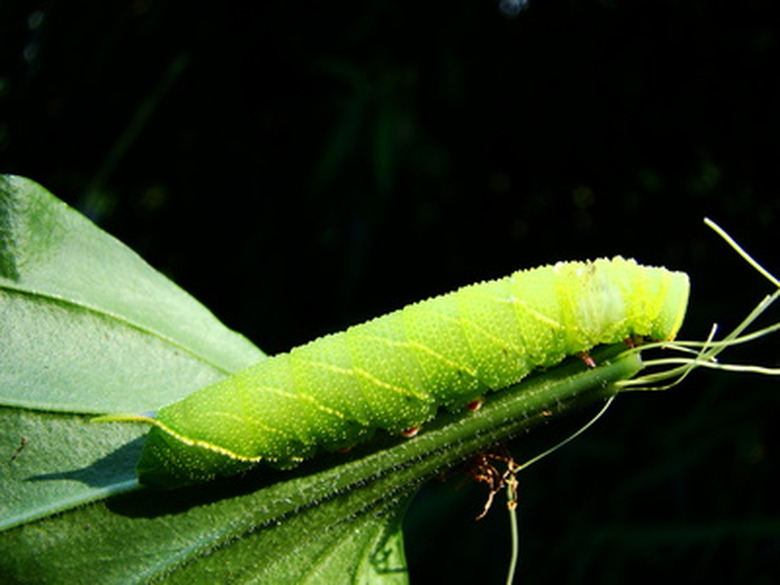Green Caterpillars That Eat Garden Plants
Caterpillars are the larvae of moths and butterflies. From the time a caterpillar hatches from the egg, it consumes vast amounts of food. Most caterpillars grow rapidly, and the larger they grow the more they eat, often shedding their skin several times until they pupate (form cocoons to begin their transformation into moths or butterflies). In large numbers, caterpillars can devastate a garden or crops in a matter of days. Insecticides may be used to kill the caterpillars, but this also kills useful insects, many of which prey on caterpillars. For smaller gardens, removing the caterpillars and eggs from the plant with a pair of tweezers is the safest environmental method. Birds also eat caterpillars, so encouraging a variety of song birds into the garden will reduce caterpillar numbers.
- Caterpillars are the larvae of moths and butterflies.
- Insecticides may be used to kill the caterpillars, but this also kills useful insects, many of which prey on caterpillars.
Lo Moth
The lo moth caterpillar (Aomeris io) is a poisonous, pale green caterpillar with red and yellow banding. This caterpillar commonly exceeds 2 inches long. The spines, which are attached to venom sacs are yellow with black tips. They feed on many common garden plants but favor roses and ixora.
Spiny Oak-Slug Caterpillar
Spiny oak-slug caterpillar (Euclea delphini) feeds mainly on deciduous trees, such as oak and willow. The spiny oak-slug caterpillar reaches ¾ inch in length. It has a comparatively mild sting, giving a short-lived nettle sensation. The spiny oak-slug caterpillar is part of the hair-caterpillar family, sporting dark hairs and spines along the sides of the body. These caterpillars can come in a variety of colors, including brown, green and pink.
- The lo moth caterpillar (Aomeris io) is a poisonous, pale green caterpillar with red and yellow banding.
- The spiny oak-slug caterpillar is part of the hair-caterpillar family, sporting dark hairs and spines along the sides of the body.
Beet Armyworm
Beet armyworms (Spodoptera exigua) favor corn, tomato and related plants such as potato, forage grasses and peas, as well as a range of flowers and weeds, including sunflowers and purslane. It reaches 1-1/4 inches, has pale green, dark green and yellow longitudinal stripes, and tends to over-winter in sub-tropical areas before migrating north in the spring. Beet armyworms can cause serious damage to flowers and vegetable crops, devouring their host plant and leaving only skeletons. Beet armyworms also burrow into the heads of lettuces, destroying the heart as they feed.
Saddleback Caterpillar
The saddleback is green, white and brown, with a stocky appearance, exceeding 1 inch in length. It is a venomous variety. The sting of a saddleback causes pain and a burning sensation, which can last up to two days. This also can be accompanied by nausea in the first several hours. The saddleback caterpillar feeds on a wide variety of common garden plants, including hibiscus, palm, shade trees and ornamental shrubs. The saddleback usually is present in late summer.
- Beet armyworms (Spodoptera exigua) favor corn, tomato and related plants such as potato, forage grasses and peas, as well as a range of flowers and weeds, including sunflowers and purslane.
- It reaches 1-1/4 inches, has pale green, dark green and yellow longitudinal stripes, and tends to over-winter in sub-tropical areas before migrating north in the spring.
Hickory Horned Devil
The caterpillar of the royal walnut moth (Citheronia regalis) is the hickory horned devil. This caterpillar reaches a length of 6 inches. The hickory horned devil is vibrant green, and has eight orange, black-tipped curving horns behind its head. Although not poisonous, the body is covered in short, stiff spines. The hickory horned devil caterpillar feeds on pecan, hickory and sumac, among others.
